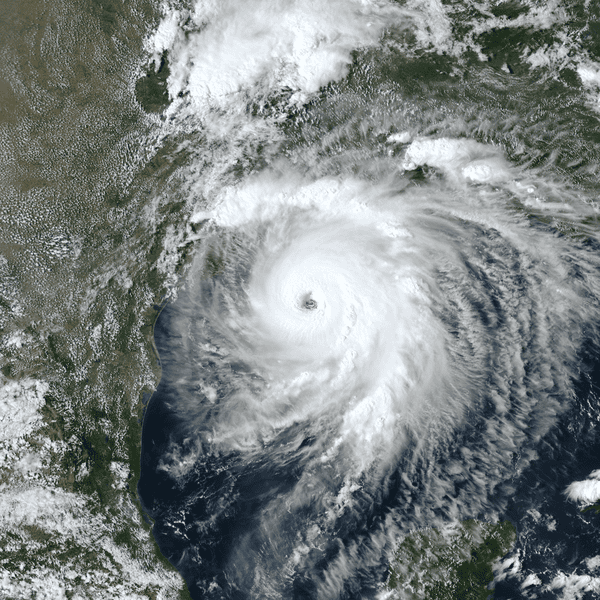August 2020 Articles:
- Atlantic Hurricane Season May Set Records!
- Basic Sizing for Mobile Generators
- Rapid Action Helps Cnter in Critical Moment
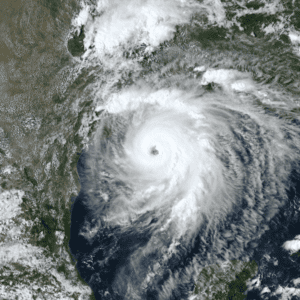 As we assess the widespread damage from Hurricane Laura, NOAA is now forecasting up to 25 named storms this 2020 Hurricane Season – with three to six major storms categorized as Category 3 or higher (winds of 111 mph).
As we assess the widespread damage from Hurricane Laura, NOAA is now forecasting up to 25 named storms this 2020 Hurricane Season – with three to six major storms categorized as Category 3 or higher (winds of 111 mph).
Thus far, we’ve had nine storms, including seven tropical storms and two hurricanes. An updated forecast from NOAA increases the chance of an above-average hurricane season from 60% to 85%.
Atmospheric and oceanic conditions are very favorable for an “extremely active” hurricane season with warmer-than-average sea surface temperatures in the tropical Atlantic Ocean and the Caribbean Sea, reduced vertical wind shear, as well as weaker tropical Atlantic trade winds.
If we do end up with the 25 storms that are forecasted, then we will run out of storm names – another milestone occurrence. Each year, twenty-one names are assigned to a hurricane season. If there are more than 21 storms, meteorologists will begin using the Greek alphabet.
With Hurricane Laura sweeping ashore as one of the most powerful storms to hit the United States, it’s vital for both coastal and inland residents to remain prepared for the next storm. Hurricane Laura’s winds topped off at 150 mph causing both severe structural damage and extensive power outages. Utility companies reported that about 404,000 customers in Louisiana and another 104,000 in Texas were without power the day after the storm, according to PowerOutage.us. The added threat of Coronavirus makes it even more important to have a preparedness plan in place.
As part of an overall storm preparedness plan, it’s time to make sure your generator will function if needed. ESSE is here to ensure your generator is in peak operating condition, call us today at 855 GEN ESSE (855 436 3773) to make an appointment for service. Our team is ready 24/7 to meet your needs. For the latest forecasts on hurricane activity visit www.hurricanes.gov.
Basic Sizing for Mobile Generators
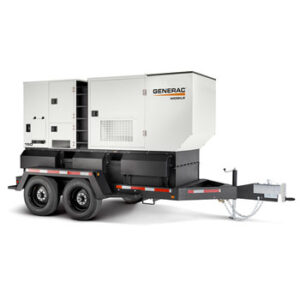
Selecting a generator that can handle all your power generation needs is one of the most critical aspects of the purchasing decision. To ensure the optimal power solution for your application, it is highly recommended that you work with your local generator representative to ensure accurate sizing. While many manufacturers provide sizing programs, it is important to understand how and why certain selections are made. This article will cover the basic aspects of the sizing process.
INTRODUCTION
Generators come in various sizes and power capacities. A common mistake that buyers often make is underestimating the starting requirements of the loads that will be connected to their generator. Generators are undersized when either the running or starting requirement of the loads are greater than the rated capacity of the generator. When a generator is overloaded, engine speed drops and the voltage and frequency become unstable, causing the amperage to surge and the generator to trip offline or shutdown. If the generator is not protected, this instability can damage equipment connected to the generator. The generator should be equipped with a main circuit breaker or individual receptacle circuit breakers that will trip when there is an overload, as well as, with protective relay elements on larger machines. These elements are often incorporated into the digital genset controller.
Oversizing a generator is also concern. The optimum power to pull from a generator is 70-85% of the machine’s rated capacity. This range provides the best efficiency and leaves some flexibility if your job requires additional power. For diesel gensets, when less than 30% of the rated capacity is applied, the generator has been oversized. This can lead to several problems, including wet stacking, where unburned fuel escapes into the exhaust side of the engine. If the engine wet stacks, engine performance decreases and costly damages to exhaust and emissions components can occur.
CALCULATING POWER NEEDS
On jobsites, you will find generators powering pumps, compressors, concrete saws, powered hand tools, lighting, portable HVAC units and job trailers. For remote operations, generators provide power where access to the utility is not available or not reliable, and where extended run times are needed. To begin determining what size generator will fit your needs, the first step should be to make a list of all the items that will be powered by the generator. You will need to calculate the total kW, KVA or Amperage to both start and run the load. If you have motor loads, the starting component becomes very important.
Why are there three different values that can be calculated for generator sizing? It all depends on the type of load and/or the information you receive from the customer. For example, if your customer simply asks for 200 amps at 208 v 3 ph, and no load information is supplied, then you can only size by the amperage given. Resistive loads, like LED or incandescent lighting, can be sized by watts or kilowatts (kW), but motors require calculating the starting kVA. So, you can use any of the values, but some will be easier than others, depending on the information you are given.
The basic types of loads are resistive and motor:
Resistive
- Have no motor
- Light bulbs, coffee maker, electric water heater, radiant heater, electric oven
- Current required to start is the same as current needed to run
Think of a 100-watt light bulb, when you turn it on, it draws 100 watts continuously
Motor – Two primary types of motors:
- Induction – refrigerator, furnace, industrial equipment (pumps, machines, large tools)
For 1Ø – They require 3-5 times the amps or watts to start them
For 3Ø – They require 7-12 times the amps or watts to start them
- Universal (brush type) – drills, power tools, blenders
Require 1−2 times the amps or watts to start them
While you are compiling your list of items that need to be powered by the generator, you need to collect certain electrical data for each item. This information should be imprinted on a data tag or nameplate located on each item. For resistive loads, you need to know the amperage, voltage and phase for each item. For motor loads, you will need the horsepower (HP) rating, amperage, voltage, phase and the NEMA Locked Rotor code – sometimes listed at KVA code or just code.
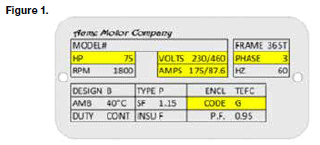
We will also need to know how motors are being started. There are several methods and devices, some of the most common are:
- Across the Line – where full system voltage is used to start the motor
- Soft Starter –auto transformer, current limiting, reduced voltage
- Variable Frequency Drive (VFD) – Need the horsepower and electrical operating ratings
If a soft starter is being used, the type and setting value are required, so that the reduction in starting kVA can be determined. If a VFD is being used, the nameplate data is required – this includes HP, amperage, voltage, phase, and running kW or kVA (if provided). It is also helpful to know if the VFD has any harmonic filtering on the line or load side.
We discussed the two basic load types earlier – motor and resistive loads, but another, more complex, load type is non-linear loads. VFD’s and UPS systems, as well as, switch-mode power supplies found in modern computing and telecom equipment are some of the most common types of non-linear loads that are encountered when sizing mobile generators. Non-linear loads create harmonics that can wreak havoc on generators due to the distortion they create in the sine wave. If no harmonic filters are being used, upsizing the alternator, or increasing the kW of the generator can compensate for the non-linear loads.
SIZING LOADS
When sizing single-phase loads, the equation is simply Amps x Volts = Watts. This will give you your running wattage. If you want the kW, you divide the watts by 1000, because 1000 watts = 1kW.
If you have a motor load and need to calculate starting wattage, use the rules of thumb that we discussed above:
- 1Ø Induction motors require 3-5 times the amps or watts to start
- 1Ø Universal motors require 1-2 times the amps or watts to start
For example, a submersible pump that draws 10 amps at 120 v, the running wattage would be 1200 watts or 1.2 kW (watts/1000). Using the rule of thumb, 1200 w x 5, the starting or surge wattage would be 6000 watts or 6 kW. So when selecting a generator, you need to make sure that it has a surge rating of at least 6000 w.
You can use the following formulas to find the amps, volts, wattage or kW of any single-phase device by inserting the values that you have:

When calculating 3 phase loads, additional factors need to be considered. Power Factor (PF) is the ratio of Real Power (kW) to Apparent Power (kVA). Three phase generator sets are rated in kVA at a 0.8 lagging PF, this is the nominal PF used to calculate the kW output of an engine that is driving a particular alternator’s kVA output. So a 100 kVA 3-phase genset has a real power output of 80 kW (100*.8). Real power is the actual usable power; kW and kVA are the same for single-phase gensets because the power factor is 1.0.
The other factor that needs to be taken into account is the 3-phase multiplier constant of 1.732. This is derived from the square root of three. Using the following equations, you can determine the kW, kVA or amperage of any 3-phase system.
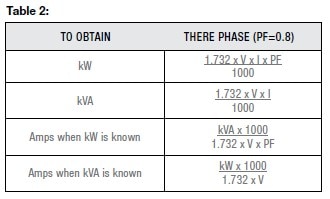
THREE PHASE MOTOR LOADS
It is critical to understand the starting methods used for 3-phase motor loads. Each has unique requirements and affect what size generator is required to start the motor. Unlike the utility grid, generators are limited in their motor starting capacity based on the capability of their alternator.
Across the line, starting is the method where the full system voltage is used to start the motor. It usually involves the use of a magnetic motor starter and requires the highest starting kVA (skVA) from the genset. Calculating skVA requirements for this method is accomplished via the locked rotor method.
All NEMA rated motors have a motor nameplate that includes the NEMA locked rotor code, which determines the kVA required per HP for motor starting. Table 1 lists the kVA per HP range associated with each NEMA Code. The most common codes found in 3-phase industrial motors are G, H, J & K, with G considered the most widely used.
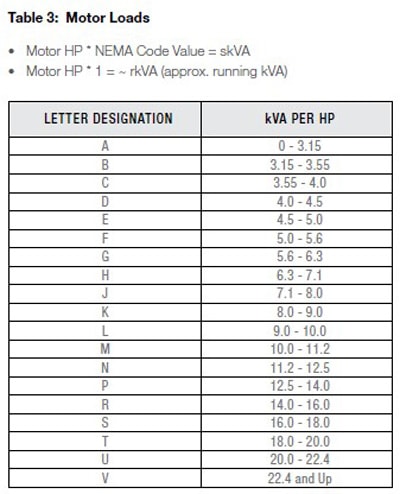
Calculating the skVA for a 100 hp, NEMA Code G motor using the locked rotor method entails multiplying the HP by the corresponding value for Code G. My personal preference is to use the higher value. Multiplying 100 hp * 6.3 kVA = 630 skVA required to start this motor across the line. You can then match this requirement to a generator in your fleet that meets or exceeds this skVA output. Keep in mind that we also need to calculate the running kVA, to make sure that the motor is running kVA is not less than 30% of the generator’s kVA rating to prevent lite loading.
- NEMA Code G 100 hp motor would need 630 skVA from a genset to start.
- However only ~100 kVA is needed to run it.
Frequency dip and voltage dip tolerance also need to be considered when selecting a genset. Frequency dip occurs when a genset is hit with a large load and the engine’s RPM drops as it tries to respond to the load demand. As the RPM’s dip, so does the frequency output of the alternator. Most industrial loads, like motors, can handle a 10% frequency dip, but some sensitive electronics have tighter tolerances. Likewise, voltage dip occurs during motor starting due to the higher inrush current drawn by the motor. Manufacturers and consulting engineers will specify the minimum allowable voltage dip for an application.
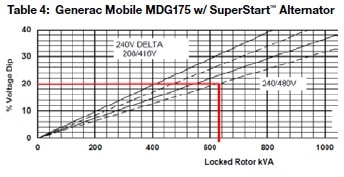
From our example above, the Generac Mobile MDG175 with a SuperStart™ alternator can start the 100 hp Code G motor with a 20% voltage dip as shown in the starting curve below. It would run the 100 hp motor at ~57% load (~100 kVA/175 kVA), which would be acceptable to mitigate lite loading.
STARTING AIDS
Soft starters and VFD’s are widely used to minimize the starting kVA effects of motor loads on generator sizing. Soft Starter is a general term that describes a motor starter that reduces the power required to start a motor. There are many varieties of soft starters on the market; some of the common types are primary resistor, autotransformer, part winding, wye delta and solid state.
Understanding the operational characteristics and settings of each type is extremely important when calculating skVA. Some soft starters have the ability to start at low voltage and ramp up to full voltage. In this configuration, generator excitation and governor response is such that there are no voltage or frequency transients. Some soft starters’ ramp voltage until a preset current limit is reached. This preset current limit will determine the size of generator required.
Two of the most widely used soft starters are autotransformer and solid state. Auto Transformer styles have voltage tap settings, and solid state have current limit settings, each corresponding to a reduction in the skVA required to start the motor.
Auto Transformer: Taps set to provide 80%, 65% and 50% of the line voltage and provide a 20%, 35% and 50% reduction in skVA.
Solid State: Adjustable Current Limit Settings between
150-600%600% = across the line starting (no skVA reduction)
300% = a 50% reduction in skVA
150% = a 75% reduction in skVA
Looking at our 100 hp example above, a solid state soft starter with a 300% current limit setting would reduce our skVA from 630 across the line, down to 315 skVA, resulting in a smaller genset being used.
Variable Frequency Drives (VFD) vary voltage and frequency, allowing them to control motor starting, stopping and speed rates. They are generally used to ramp up during the starting sequence and to control speed during operation. When a VFD is used, the generator no longer sees the motor as the load; the VFD becomes the load that the genset recognizes. So calculating the running kVA or kW of the VFD is required for genset sizing. We would use this equation to determine the running kW:
The current drawn by VFD’s is nonlinear (having harmonics), which causes a distorted voltage drop across the reactance of the generator. Since VFDs are nonlinear, you must include additional generator capacity when sizing to keep voltage distortion to a reasonable level of approximately 15% total harmonic distortion (THD) or less. The larger the generator, the greater the reduction in impedance of the power source (generator), which in turn, reduces the effects caused by harmonic current distortion.
For older six-pulse VFDs, a typical generator up-sizing factor would be 2X the running kW of the drive. If it is newer 12 pulse or pulse width modulated (PWM) type (or includes an input filter to limit current distortion to less than 10%), then you can reduce the sizing factor down to 1.4X the running kW of the drive. Given the need to upsize generators to compensate for harmonics, it sometimes offsets any reduction in starting kW/kVA that users were hoping to gain by adding a VFD.
OTHER CONSIDERATIONS
Proper sizing of the generator will save users money on fuel consumption and rental fees. Owners can avoid costly repairs by not having their gensets applied in undersized applications and experience wet stacking. Ensuring power cable lengths and gauges are sized to meet the voltage and amp draw of the application is another important consideration. To avoid any issues, consult with a certified electrician before renting, buying or connecting a generator to insure you comply with all federal, state and local electrical codes.
CONCLUSION
When you properly size a generator, you minimize risk and downtime from power disruptions. Considering project costs, an optimally sized generator will prevent lost revenue due to an unforeseen halt in production, cancellation of events from being unable to secure sufficient power sources, and delays in construction due to a lack of power. Over or under sizing the generator for your job, could end up adding unforeseen costs to the project. Size it right from the start and you will reap the benefits of your mobile power.
Rapid Action Helps Center in Critical Moment

In early 2020, the novel coronavirus began wreaking havoc on the world. Long-term care facilities had been particularly susceptible during the outbreak, often with devastating consequences. The developmental center saw over 100 residents and staff members test positive for the virus. In the aftermath of the diagnoses, the developmental center needed to quickly expand its safety practices, which included adding backup power.
Reliant on a robust air return system that is critical to filtering the air to ensure germs don’t recirculate and spread, the center needed five 50 kW industrial gas generators to safeguard the system and they needed them quick. With Generac’s designation as an essential infrastructure business by the Department of Homeland Security, the company maintained normal operations as the coronavirus began to the world and by doing so, was able to play a vital role in helping to fight the pandemic.
“Normally, the lead time for an order of this kind would be six to eight weeks,” said Andy Martin, senior director of operations, Generac Power Systems, Inc. “But in true Generac fashion, our people moved with an amazing sense of urgency to deliver the generators in just four days. The sales team prioritized the order, the team at our Jefferson facility expedited the parts we needed, and all three shifts in our Eagle manufacturing facility really hustled to get the units built, tested and out the door in record time.”
While the center searched for multiple ways to enhance their safety policies and practices, completing the order even faster than the one week that was originally quoted, allowed the center to begin recovering. The team at Generac said the quick turnaround shows what it means to put our customers first.
“When we were informed that a critical facility was in need of generators, it made me proud to know the work we’re doing has a positive impact on the lives of those affected,” said Alan Bowey, assembler, Generac Power Systems, Inc. “It was amazing to see what we are capable of doing when we work together toward a common goal. It makes me proud to be part of the Generac team.”
The impacts of COVID-19 have been felt globally and the virus has left its mark on every citizen in one way or another. During challenging times when people need hope, Generac leaders said team members come together to support their communities brave the time of uncertainty time after time.
“As we execute our normal work routines, it’s difficult to understand the impact we can have on other critical and essential businesses,” said Erik Wilde, EVP Industrial – Americas. “This project illustrates that our products really do make the world safer. I’m very proud of the team for their response to this need.”
